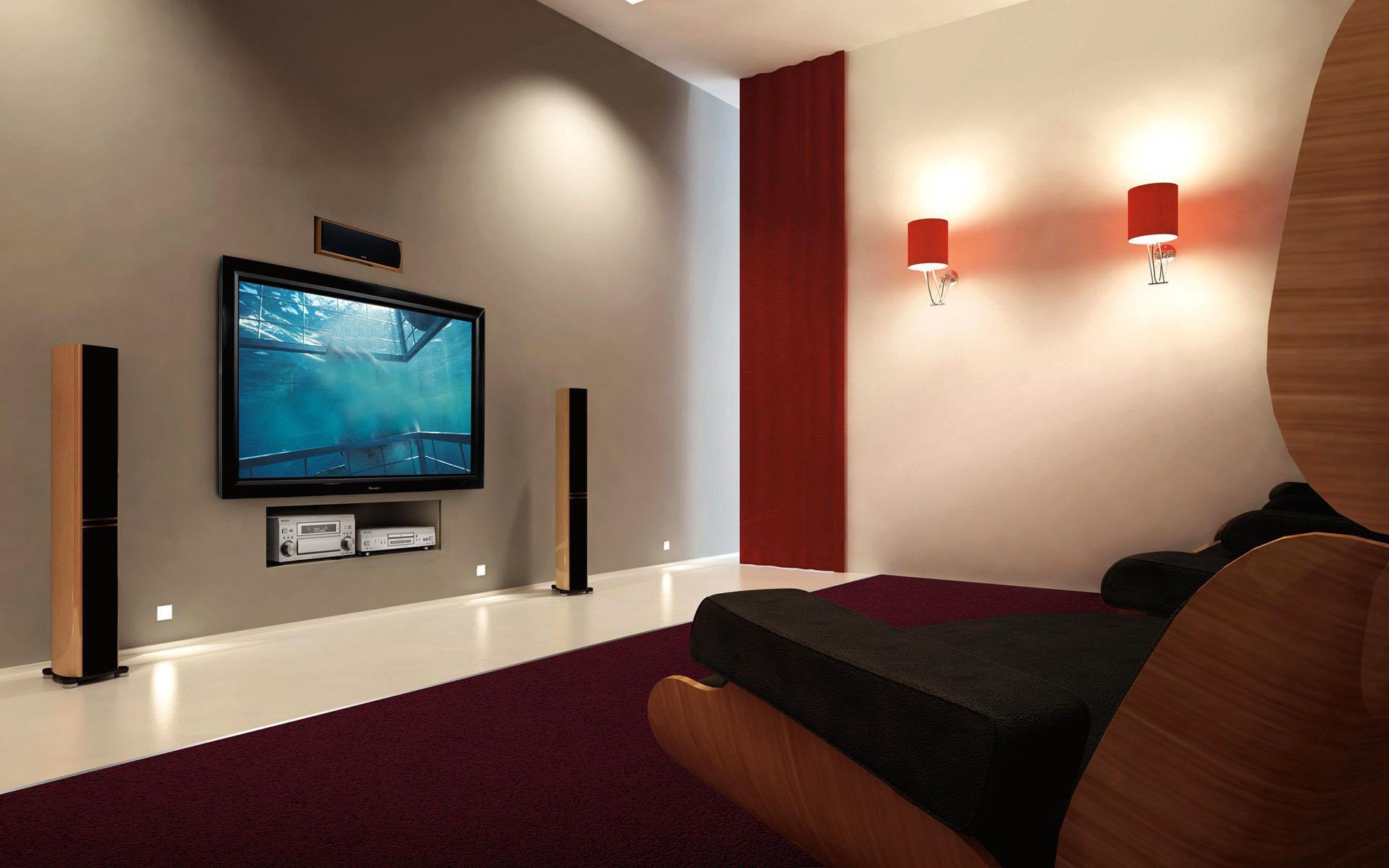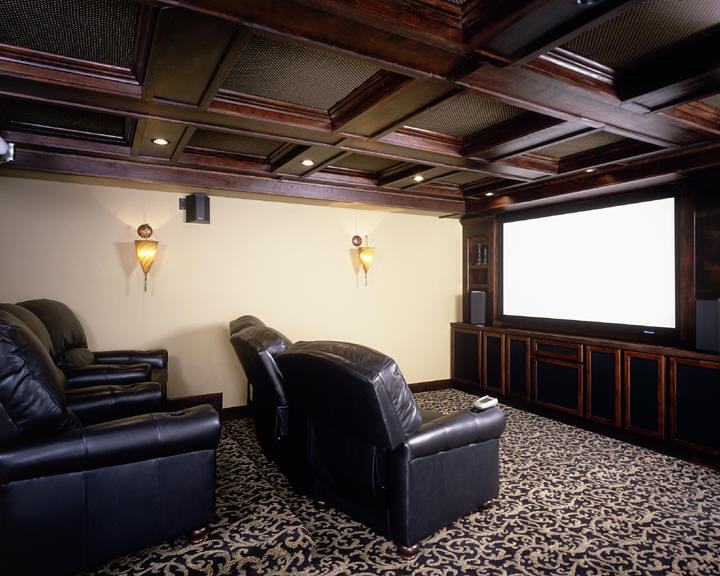Custom Room Design for Home Theaters
Tri Star Home Theater custom-built home theater


The design of a custom-built home theater combines the acoustic considerations of a multichannel audio system with the design parameters needed to achieve high-quality video rdisplay. A properly-designed and installed home theater will rival your local cinema in picture quality (unless you live in Hollywood), and will far surpass it in audio quality. Before we begin the design process, we need some information from you:
Because each video display technology has its own unique set of pros and cons, we must carefully match your needs to the right equipment's capabilities. Often front or rear projection systems best suit the requirements, although a high-definition direct view television or a flat screen are sometimes best. On occasion we even use more than one technology in a single room. Now that we know what you'll be watching in the room, we can turn to designing the room itself.
Ideally, we would like to size the room specifically for your needs. The general size of the room will determine the number of people who can comfortably watch the theater at one time. For acoustic reasons, the ratio of the room dimensions is extremely important. Click room dimensions for more info.
Many times however a home theater is a retrofit of an existing space. Sometimes one or more of the dimensions (length, width, and height) are constrained by other considerations, such as budget or an existing space within the building. However regardless of your room size, we have a wide variety of techniques to enhance both the video quality and sonic performance of your system.
Consider converting basement space into a home theater. It will add useable square footage to your home and enhance it's resale value. Also, the lack of windows in the basement may complement the home theater's need for darkness.Building a new house? If you are building a new home, but don't want to build the home theater right away, consider adding a foot or two to the ceiling height in the basement to more gracefully accommodate a future home theater. Plan the space now so that ductwork, structural columns, and other obstacles don't have to be moved later. Also, ensure that your foundation drainage system and vapor barrier will guarantee a dry basement.
When designing a room, we carefully consider where the listeners/viewers will sit and where each speaker will be positioned. The acoustic design of the room must accommodate not just sound coming from the front left and right speakers, but also from the center front and from the rear and/or sides. Each occupant needs a clear line of sight to the screen and ideally a clear line of sight to each speaker. If you plan to listen extensively to stereo music, then we need to perform additional acoustic planning to ensure that you realize the full capabilities of your system.
We carefully plan the placement and construction of doors and windows. From an acoustic perspective, doors and windows can deleteriously resonate, reflect, and leak sound. From a video perspective, even window's with heavy curtains will leak light, which may then need to be controlled with special "blackout" blinds. Also, the windows and doors should be located where the won't conflict with the preferred screen and speaker placements.
As for the walls, we specify the construction of inert, anti-resonant walls. We also want them to be somewhat rigid, but not so rigid that they won't let any bass energy escape. Excessively rigid walls would require extensive bass trapping to acoustically treat the room. Often we specify walls that are of medium mass but that are also internally damped and can flex in a controlled manner. Click room construction for more info.
Once we have the proper design for the acoustics within the room, we consider any requirements for soundproofing. In many situations, we need to keep external noise out of the room. For example, the noise from a busy road can very annoying. Or perhaps you may wish to keep loud movie soundtracks from being transmitted to other parts of the home. Also, some audio and video components make mechanical noise, either from a fan or from their operation. We can design baffles and ventilation systems to prevent this noise from intruding on your listening. Click soundproofing for more info.
The AC electrical system should be designed and installed with great care. For the highest quality systems, we specify heavy-duty dedicated electrically isolated circuits, with special attention to capacity, shielding, and grounding. We recommend hospital grade outlets and heavy duty circuit breakers, or even new high-end breaker boxes that don't use the normal pull-out circuit breakers. Click electrical system for more info.
A good HVAC design will help achieve a low noise floor in the room. We pay special attention to avoid sound transmission problems when the ductwork connects to noisy elements such fans, furnaces, and compressors. We recommend ducts that are lined on the inside and wrapped on the outside. Click HVAC for more info.
Some metropolitan areas have well-known areas with high levels of TV, radio, telephone, and other types of high frequency air-borne signals. Some audio and video system can pick up and amplify these signals as unwanted background noise. If you are building in such an area, please let us know as we can minimize the effects of these signals with the design of the room. Click RF/EMI shielding for more info.
Any high-end room requires a careful lighting plan by a qualified lighting designer. However, many of the electrical components that lighting designers use generate large amount of electrical noise which degrade the performance of the system. If the home theater will sometimes be used with the lights on (for example, to listen to music), then we take special precautions retain the system's high level of performance. Click lighting for more info.
Depending upon the display technology used in the video system, the color scheme of the room may be quite important. Front projection systems in particular benefit from a dark, neutral color scheme. Black is ideal, but neutral grey or grey-like colors such as charcoal or taupe can work almost as well. Other colors, especially on the areas closest to the screen, will be less optimal. Burgundy, a popular cinema-like home theater color scheme is not a particularly good choice as it will tint the picture pink. White or light colors are the least optimal as they will reflect light back onto the screen, which will wash out the blacks, making them look grey instead. If you are using an interior designer on your project, we suggest that we work with them to create high-performance, great looking home theater. We have techniques which can either ameliorate or eliminate the performance problems with just about any color scheme.
In addition to color, texture can be important as well. A high gloss paint for example will deleteriously reflect light. Image a shiny new black car and you'll understand the problem. Flat or almost flat paint works much better. As an alternative, we can install a stretched cloth system on the walls and ceiling. The effect can be stunning visually and non-reflective optically. As a bonus, a cloth wall system can conceal acoustic treatments, giving a clean, sleek look to even the most highly treated room.


At Tri Star Home Theater we never charge for an estimate, unlike some of our competitors,
At Tri Star consultation is always Free! Call Today with... NO Obligation!